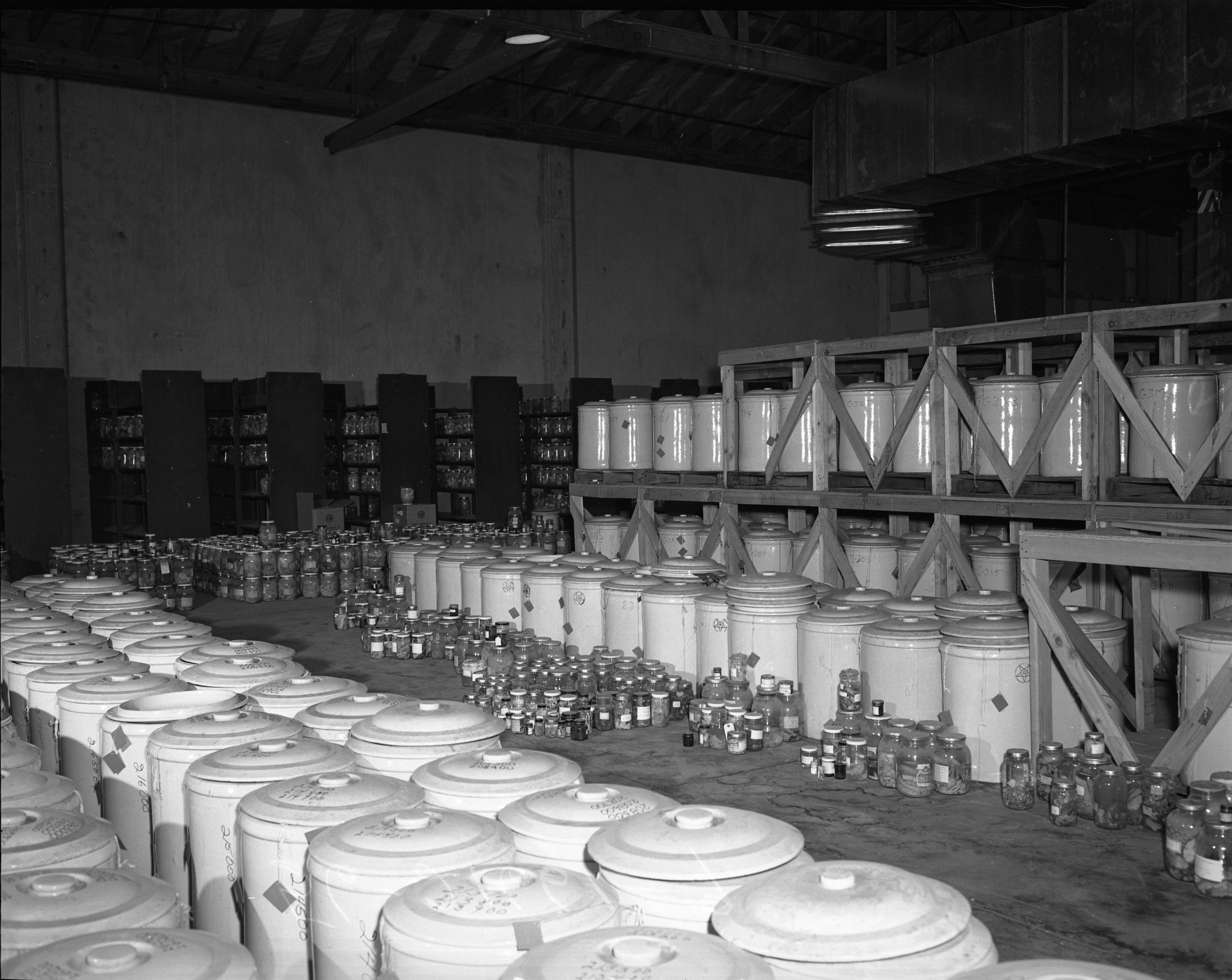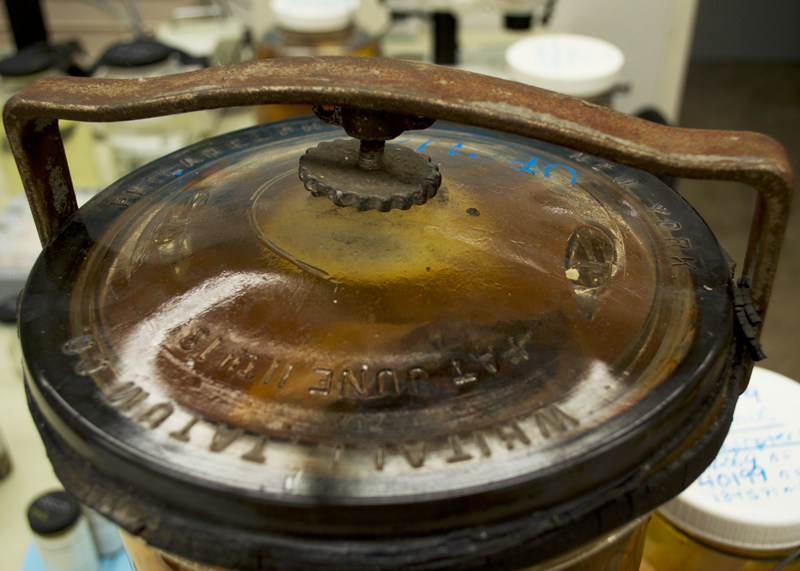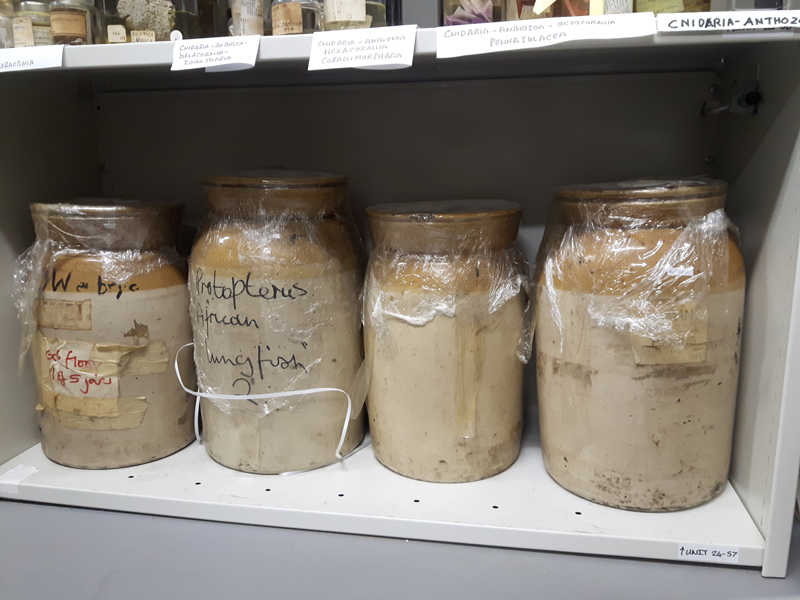Natural History Museums Once Fermented Reptiles in Household Pickling Crocks
The ceramic jars were cost-effective for storing specimens, but brought nasty surprises when unsealed.

Among the thousands of glittering glass jars in the Ichthyology collection storeroom at the Florida Museum of Natural History are a few enormous, dusty, ceramic crocks. These vessels are currently empty, but the cryptic numbering and globby drips down their outsides hint at their past scientific purpose. George Burgess, the emeritus Director of the Florida Program for Shark Research, still remembers plunging his hands into their dark depths to retrieve fish specimens preserved in alcohol, though it has been close to 30 years since the containers held anything besides cobwebs. With Burgess’s recent retirement, now there is no one employed at the museum who ever used these once indispensable vessels.

At the turn of the 20th century, natural history museums around the world were growing at a rapid rate. The foundations of their collections were comparative specimens, examples of known plants, animals, and other natural or cultural items that researchers used for identification and study. These included complete animals such as fishes and reptiles best preserved in fluids to maintain their soft tissue. However, what to do when your stingray or iguana was too big to store in a standard glass jar? Resourceful curators looked around their homes and turned to a familiar form: the pickle crock.
These containers were originally produced as fermentation vessels for preserving vegetables, fish, and meat on homesteads of the American Midwest. In the early 20th century, they would have been familiar to many people, who had similar crocks in a corner of their kitchen, full of sauerkraut or other foods. Burgess recalls jars like these in his childhood home on Long Island, New York, where he would sneak down to the cellar, crack open the heavy lid and extract a pickled herring for a snack. When he first saw them in a museum setting, he knew exactly what they were.

In museums, they came to preserve a different kind of pickled fish: scientific specimens in alcohol or formalin. Prior to the 1950s, large glass jars were expensive and fragile. A 10-gallon glass specimen jar would have cost nearly $25 in 1919, the equivalent of $350 today. Metal containers, though more affordable, corroded quickly. Instead, scientists began to extol the virtues of stoneware crocks as economical and practical long-term storage options. In contrast to the glass jar, a 10-gallon crock cost only $5, or the equivalent of $75 today. For much of the 20th century, ceramic crocks were common in storerooms of museums across the United States. Canadian and British museums stored specimens in similar vessels, including large butter churns.
Sturdy fermentation jars were used to preserve whole specimens, but also for “bacterial maceration.” That’s the scientific process of leaving an animal carcass submerged in water and letting the soft tissue rot away.

While Dr. Thomas LaDuke was a graduate student at Michigan State University in the 1980s, he worked in the school’s museum, where one of his jobs was preparing reptile specimens: “I can still remember reaching into that nasty smelling crock to scoop up a handful of muck filled with nice clean monitor lizard bones,” he says. “That is a smell you’ll never forget!”
Pickle crocks filled a need, but imperfectly. They were exceedingly heavy. To slow evaporation, jars had to be sealed with messy mixtures of beeswax, paraffin, and petroleum jelly. Though they were sturdier than glass jars, they were opaque, making it more difficult to quickly identify and monitor contents. Without routine refills of preservation fluid, the animals inside would begin to decay.
Jack Ashby of the Grant Museum of Zoology at University College London described some of their perils: “These jars are pretty horrific. We haven’t opened them for about 10 years,” he says. “The last time I tried, a cloud of black spores exploded in my face, as the fluid had pretty much gone and the otter inside was covered in mold. Since then they’ve always been a problem for another day.”

Over the latter half of the 20th century museums have gradually transferred their specimens into improved modern glass jars, steel caskets, or plastic barrels. Now, in all but a few museums, stoneware pickle crocks have disappeared. Some relict jars still linger forgotten on museum shelves, but given space constraints, perhaps not for much longer. At the Florida Museum of Natural History, the century-old crocks are about to make a move, from Ichthyology to the Ceramic Technology Laboratory. There, they’ll be studied as historical specimens in their own right.




















Follow us on Twitter to get the latest on the world's hidden wonders.
Like us on Facebook to get the latest on the world's hidden wonders.
Follow us on Twitter Like us on Facebook